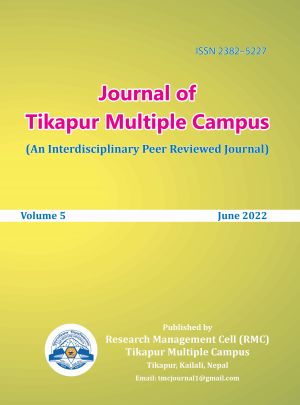A Review on Major Diseases of Citrus in Nepal and their Management
DOI:
https://doi.org/10.3126/jotmc.v5i1.46522Keywords:
Citrus, Citrus diseases, Citrus decline, citrus root nematode, citrus tristezaAbstract
Citrus is one of the most important fruit crops cultivated in tropical and subtropical regions of Nepal. Climatic conditions of mid hill regions of Nepal having an altitude ranged between 800 to 2100 meter above sea level are conducive for all types of citrus fruit cultivation. Nepal produced 273,000 tons of citrus in 2019 and ranked 43rd in global citrus production. The average productivity was 9.4 mt/ha in 2017/18.Various biotic and abiotic factors are reported to decline productivity of the citrus in Nepal. Poor orchard management, improper manuring and fertilization, including insect pests and diseases are major factors for citrus decline and low productivity of the citrus in Nepal. A literature review was carried out to explore the common diseases of citrus and their management in the context of Nepal. Along with the diseases of citrus, their casual organisms, distribution, epidemiology, intensity, symptoms, survival or spread, environmental factors, losses incurred and integrated management strategies corresponded to citrus diseases of Nepal gathered and compiled thoroughly from different literature and websites. Different 16 fungal diseases, 42 viruses, 7 bacterial diseases and some nematodes causing diseases on citrus in addition to this many diseases are reported to attack citrus crops in Nepal. Citrus greening (HLB), Phytopthora induced diseases, citrus canker, citrus tristeza, twig blight, powdery mildew etc. are major yield limiting diseases of citrus. Anthracnose, sooty mould, pink disease, gummosis, scab disease, citrus root nematodes, ‘Ainjeru’ are the other diseases for declining citrus production and its quality. Citrus greening and citrus tristeza are major casual agents for rapid decline and citrus root nematode is considered as casual factor for slow decline of citrus.
Downloads
Downloads
Published
How to Cite
Issue
Section
License
Copyright (c) 2022 Prem Pandey

This work is licensed under a Creative Commons Attribution-NonCommercial 4.0 International License.
This license enables reusers to distribute, remix, adapt, and build upon the material in any medium or format, so long as attribution is given to the creator. The license allows for commercial use.




